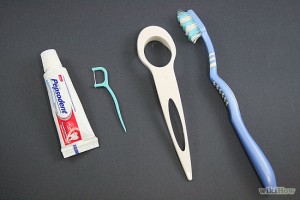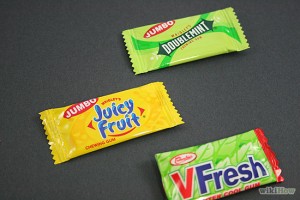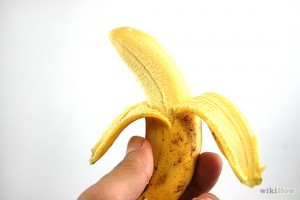-
1
Clean your mouth thoroughly and regularly; also brushing between the tongue and teeth, not just to look good, but for oral health and cleaner breath.
Two major sources of mouth odor are bacteria and decaying food particles. There are hundreds of nooks and crannies in the fertile landscape of your mouth where these offending bits of “rot” can get lodged. Brushing is not enough.- Clean your tongue. Your tongue, unfortunately, is like a shaggy carpet where all kinds of smelly stuff can hide. Suction your tongue, a little — and always swish your drinks all around the mouth and between teeth to dislodge some of this this material. When you brush your teeth (which should be at least twice a day):
Use your toothbrush, the edge of a spoon, or a tongue cleaner to “scrape” your tongue.
- If you have a sensitive gag reflex, you might not like this task. You need to clean your entire tongue, including the part close to your tonsils. Read How to Suppress the Gag Reflex for some tips.
- Floss. Make it as much of a mindless habit as brushing your teeth. At first, your gums might bleed as you dislodge chunks of food that have “stuck” to your teeth and gum for who knows how long. But take a second to smell the floss after you pass it through your teeth, if you dare. You’ll see (or smell) where the bad breath is coming from.
- Use mouthwash. Mouthwash helps to keep your mouth moist and helps to prevent bad breath.
- Clean your tongue. Your tongue, unfortunately, is like a shaggy carpet where all kinds of smelly stuff can hide. Suction your tongue, a little — and always swish your drinks all around the mouth and between teeth to dislodge some of this this material. When you brush your teeth (which should be at least twice a day):
-
2
Keep your mouth moisturized. A dry mouth is a stinky mouth. That’s why your breath is worse in the morning; your mouth produces less saliva as you sleep. Saliva is the enemy of bad breath because not only does it physically wash bacteria and food particles away, but it also has antiseptic and enzymes that kill bacteria.
- Chewing gum stimulates saliva production (in addition to covering up the odor with some kind of scent). Mints do not encourage saliva production.
- Drink water. Swish the water between your teeth from side to side. Water won’t necessarily increase saliva production, but it’ll wash out your mouth — and it’s good for you. See How to Drink More Water Every Day.
- Dry mouth can be caused by certain medications and medical conditions. Ask your doctor about switching medications, or addressing the underlying condition.
-
3
Choose your gum carefully. As mentioned in the previous step, any gum will help with bad breath because the chewing action results in more saliva being produced. Some gums, however, have better bad-breath-fighting abilities than others:
- Cinnamon flavoring seems to be especially effective in reducing bacteria counts in your mouth.
- Look for gum sweetened with xylitol. For one thing, sugar’s not good for your mouth. Xylitol is a sugar substitute that actually works to prevent bacteria from replicating in the mouth.
-
4
Eat a banana. You probably already know to avoid notorious stink foods like onions, garlic, cheese, and coffee (or at least brush vigorously after eating them). But did you know that if you’re on a low-carb diet, you might have “ketone breath”? Basically, as your body breaks down fats instead of carbs for energy, it creates ketones, some of which are released in your mouth. Unfortunately, ketones smell bad, and so will your breath. If you’re on a strict carb-restricting diet, or any diet that forces you to burn fat instead of carbs, consider throwing healthy carb-rich snacks into the mix, like apples or bananas.
- This will also happen to anyone who fasts, whether for religious reasons, or because they are anorexic. If you are anorexic, bad breath is only one of the reasons to stop starving yourself. Read How to Cope if You Want to Become Anorexic.
-
5
Talk to a doctor. If you’ve followed the above steps diligently and the bad breath persists, you may have a medical issue that needs to be treated. Here are some of the potential culprits:
- Tonsil stones. These are lumps of calcified food, mucus and bacteria that appear as white spots on your tonsils. If seen, they can be mistaken for a throat infection, although sometimes they are not visible to the naked eye. You might also notice a metallic taste in your mouth, and/or pain when swallowing.
- Diabetic ketoacidosis. If you have diabetes, it may be causing your body to burn fat instead of glucose, creating the ketone breath referred to in the previous step. This is a serious condition that needs to be treated as soon as possible.
- Trimethylaminuria. If your body can’t break down a chemical called trimethylamine, it will be released in your saliva, causing bad breath. It’ll also be released in your sweat, so persistent body odor might be an accompanying symptom
- Article from http://www.wikihow.com/Get-Rid-of-Bad-Breath
August 6th is National Fresh Breath Day
Posted in Uncategorized







